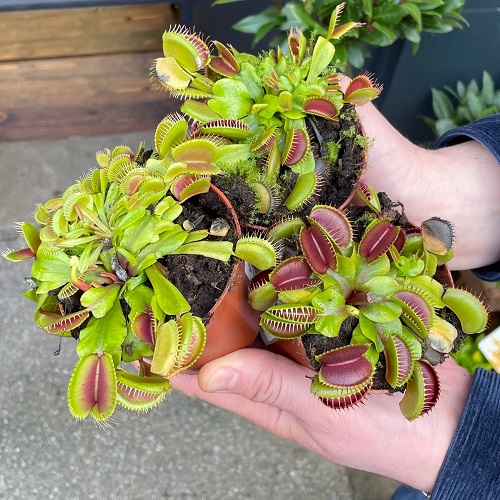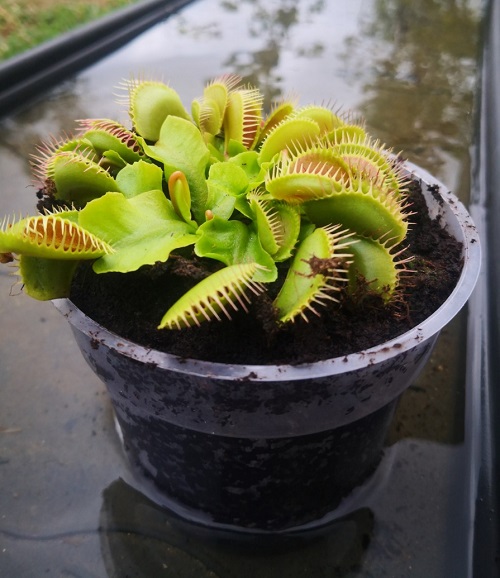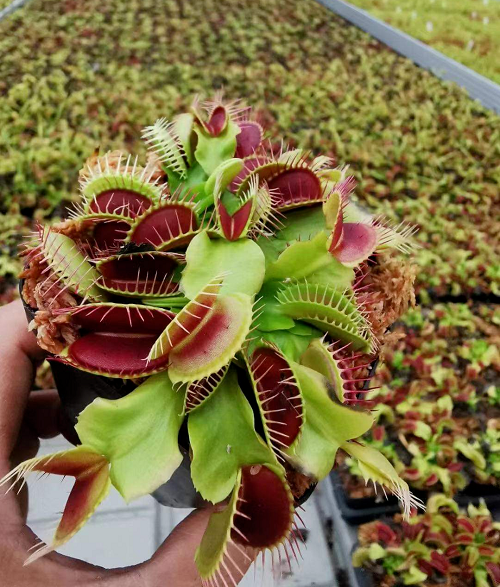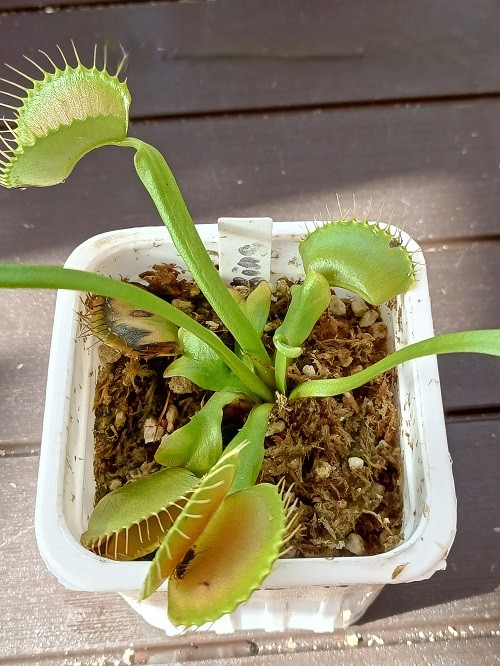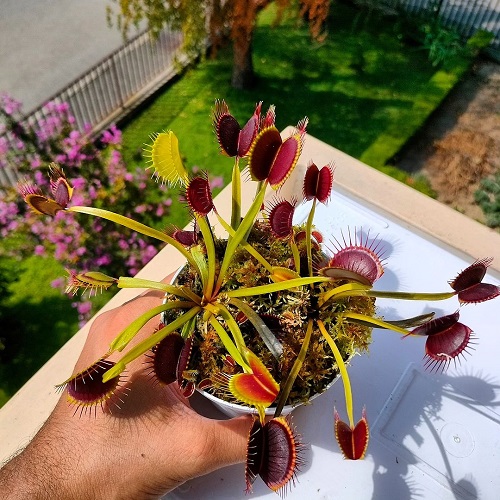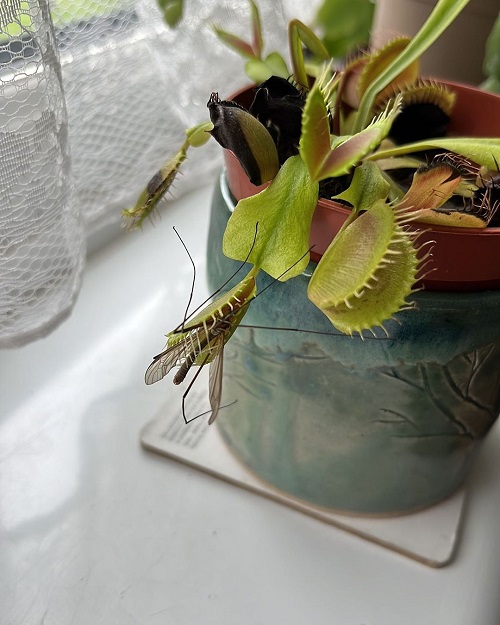If you are looking for ways on How to Grow a Big Venus Fly Trap Plant then we have some cool tips that will help you achieve your dream!
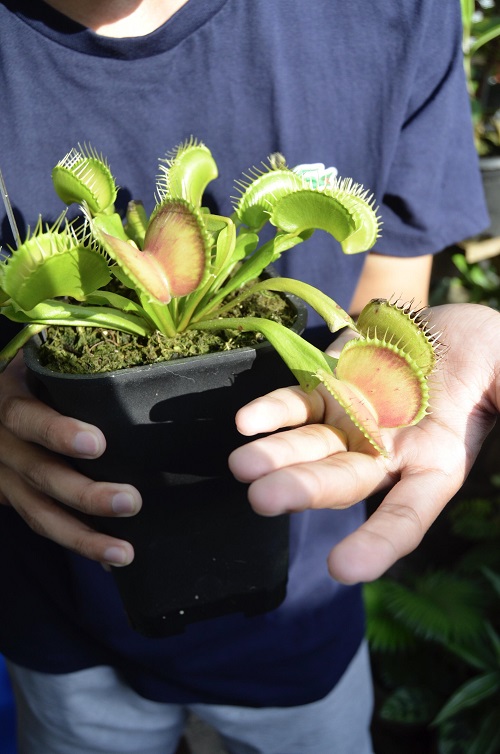
Learning How to Grow a Big Venus Fly Trap Plant is an art – from selecting the right soil mix to understanding its unique feeding requirements, we’ll tell you everything to make this carnivorous plant a living giant!
Here’s what you need to feed to your Venus Fly Traps
Venus Fly Trap Plant – Their Size and Spread in General
Venus flytraps (Dionaea muscipula) are native to a limited region in the United States. They are indigenous to subtropical wetlands in parts of North and South Carolina. They are small, distinctive plants that can reach a height of about 4 to 6 inches when fully mature when grown as houseplants.
Leaf and Trap Size Details
- Each leaf, including the trap, measures approximately 3 to 7 inches long.
- The actual trap portion is usually around 1-2 inches long.
- The size of the traps can vary, influenced by factors such as the plant’s age and environmental conditions.
Spread and Height in Detail
- The spread of a Venus flytrap, which refers to the diameter of the plant, including its leaves (Along with its stem), typically ranges from 5 to 7 inches.
- In terms of height, Venus flytraps maintain a relatively low profile, growing vertically to about 4 to 6 inches. It can extend to 8-12 inches if it grows flowers.
- During their dormant period in winter, the plants may appear smaller as some leaves die back or shrivel.
Fun Fact: Venus fly traps may appear quite large in pictures, but they are quite tiny in person!
Giant Venus Fly Trap Plant Varieties
These plants are measured according to their trap size. These giant varieties have 1.5-2 inches trap size, unlike their counterparts, which have 0.5-1 inches.
1. Dionaea Muscipula ‘B52’
Size: Up to 2 inches in trap size.
This variety is renowned for its large trap size. The ‘B52’ achieves its impressive size due to its vigorous growth rate and efficient photosynthesis.
2. Dionaea Muscipula ‘DC XL’
Size: Traps can reach over 1.5 inches.
The ‘DC XL’ stands out for its broad traps. It grows large by maximizing light absorption and efficient nutrient uptake from its prey.
3. Dionaea Muscipula ‘South West Giant’
Size: Traps over 1.5 inches.
Known for its sprawling trap size, this variety thrives in optimal humidity and light conditions, allowing for greater growth.
Check out Best Carnivorous Houseplants here
4. Dionaea Muscipula ‘King Henry’
Size: Large traps, around 1.5 inches.
‘King Henry’ is a robust grower, benefiting from a strong root system and high insect nutrient absorption efficiency.
5. Dionaea Muscipula ‘Ginormous’

Size: Up to 2 inches in trap size.
True to its name, ‘Ginormous’ develops large traps through a combination of high light exposure and consistent feeding.
How to Grow a Big Venus Fly Trap Plant?
1. Maximize Sunlight Exposure
Venus Fly Traps crave sunlight. Position them where they can bask in direct sunlight for at least 4-5 hours a day. This will help them to develop their trap sizes to the max.
2. Use the Right Type of Water for Consistent Moisture
Use distilled, RO, or rainwater and keep the soil moist but not waterlogged. Moisten the growing medium only when it feels slightly dry to the touch.
Note: Do not let the growing medium dry out completely.
Check 17 Ideas & Tips For Growing Carnivorous Plants In Containers here
3. Feeding for Size
Though you don’t have to additionally feed these plants as they get all the nutrients they need from their diet of insects, here’s what you can try to grow their size.
Get an orchid liquid fertilizer (Or a balanced liquid fertilizer) and dilute 10ml of it with 100ml of water. Now, use this solution to spray the leaves once in 10 days. This may be a trial and error thing, but it can increase the size of the plant and its traps.
Note: This should be done sparingly to avoid foliage and root burn.
4. Temperature and Humidity Control
Maintain a humid environment, especially in drier climates. A range of 70-95°F is ideal if you want to see your Venus fly traps achieve their biggest size!
8 Carnivorous Plant Terrarium Ideas | Carnivorous Plants For Terrariums
5. Re-potting for Growth
A plant trapped in a small pot for years may not achieve its full potential. Re-pot every 2-3 years to provide fresh soil and room for root expansion, contributing to the overall size.
Do not use an overly large pot – a new container, just one size bigger than the old one, will be perfect.
6. Selective Pruning
When dead traps are pruned, the plant conserves energy that would otherwise be spent on these non-functional parts. This allows the plant to redirect its energy towards producing new, healthier traps and leaves.
The conserved energy can result in the growth of larger traps, which are more efficient in capturing prey. With more significant and healthier leaves, the plant can perform photosynthesis more effectively, further boosting its overall health.
Important: Before you embark on the journey of growing the biggest or giant Venus fly trap plant, remember that these plants can’t grow bigger than you expect them to. The biggest varieties have a trap size of a maximum of 2 inches – so you can imagine!
You can surely use some of the tips mentioned above to help them thrive better and enhance their growth but do not expect dramatic results.
Check out Weird Fly Eating Plants & How To Grow Them here
Maximizing Dormancy for Growth in Venus Fly Traps
